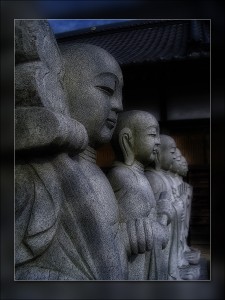1/26 Practice Circle: Benefactor Meditation

For several years now, the mindfulness group I practice with has been learning a set of meditation practices adapted by John Makransky from Tibetan dzogchen and mahamudra methods. Although these techniques have much in common with the mindfulness practices adapted from Theravada Buddhism, such as vipassana and loving kindness meditation, there are some differences in emphasis and style that I think makes them very useful and accessible, so I’ve been sharing them with the Practice Circle group. One such practice involves working with benefactors, and we’ll be trying it out when Practice Circle meets this Sunday, January 26, at 8 pm Central time.
Benefactor practice is another form of visualization meditation that helps us open the heart. A benefactor can be anyone for whom you have stong positive regard. It might be a parent, grandparent, or favorite aunt or uncle. Your benefactor might be a beloved friend or partner. You might choose a dharma teacher you admire and care for. But you don’t have to have had a relationship with your benefactor — you could choose a stranger who showed you some kindness, or someone you see at the store or at work whose smile lights up your day. You might choose a public figure who signifies compassion to you. Benefactors don’t even have to be people. A favorite pet may be a benefactor, or even a place, such as a sea shore, desert or mountain, from which you draw peace and strength. Benefactors don’t have to be perfect people — just someone who opens your heart as you think about them. And you don’t have to limit yourself to one benefactor. If you are fortunate enough to have a number of such inspiring individuals, you can imagine all of them in your presence.
The practice we’ll be sharing at Practice Circle starts with a considerable period of relaxing the body and opening the heart and mind. We’ll start with deep abdominal breathing that helps bring our awareness “down” out of the head and deep into the body. Then we’ll continue with the “three letting be’s”, a practice of simply releasing any tension or holding in the body, breath, and mind, trying as best we can to simply experience whatever arises in our awareness and let it be just as it is. This practice helps us develop a deep acceptance and an awareness of the essential wholeness of our experience.
The invitation then is simply to bring a benefactor to mind. Imagine his or her face before you in as much detail as you can. You might imagine them sitting close in front of you, smilng at you with unconditional acceptance and caring. They might stand beside you, holding your hand, giving you a hug, or placing their hand on your shoulder. Or if you associate this person with a particular memory that opens your heart, you could bring the details of that memory to mind. The specifics of how you imagine your benefactor aren’t important. What’s important is that your imagined encounter with your benefactor touches your heart as effortlessly as possible, without your having to force or judge your experience.
Then, just notice what’s going on for you. What sensations arise, and what are they like? If you are experiencing something happening in your heart center, what does it feel like? Does it have boundaries? Look carefully — is it one feeling, or are there several arising together? If so, can you tell them apart? Is it possible to let your entire awareness rest in the sensations? If the sensations fade or become abstract, simply refresh your visualization of your benefactor as easily as you can.
See if it’s possible to imagine the loving feelings in your heart center as a kind of light or energy that can permeate your awareness and radiate to every cell in your body. Accept it, rest in it. As best you can, allow any judgements or doubts to come up and release without grasping at them. Feel the loving radiance touch you deep inside, shining into places of pain, fear, anger and suffering. Let no place inside you remain untouched by it. What happens in your awareness as you imagine this?
You can extend this practice by offering the radiance of love and compassion to beloved, neutral, and difficult people, and to all people everywhere, just as you would in loving kindness meditation. You can imagine your benefactors behind you, as the care and acceptance they have given you is shared with others.
Finally, let the visualizations go, let the practice go, and just return to resting the body, the breath, and the mind, letting everything be just as it is without grasping and resistance.
As with all such visualization practices, benefactor practices aren’t magic. They are a way of engaging the imagination to help us experience the healing nature of deep self acceptance and self compassion. Engaging that healing capacity strengthens the neurological structures that generate the experience of love and compassion, and makes that response more available to us in our everyday lives. And it helps us recognize and develop gratitude for all the people, places and beings whose acts of kindness toward us sustain our lives.
If you haven’t joined us at Practice Circe before, we warmly welcome you to our online practice community. Practice Circle is the SBA’s online meditation and discussion community. We meet via video conference on the second and fourth Sundays of each month. Practice Circle is free to attend, and everyone is welcome. Just click this link on Sunday evening to attend.
